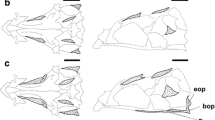Abstract
The development of the skull skeleton in common dentex, Dentex dentex (Linnaeus, 1758), was studied under extensive rearing conditions. Skull ontogeny started after hatching and went through three stages: (a) the yolk-sac (during the phase of no growth) and the early larval stage (up to 6.9 mm in vivo total length, TL) in which the majority of the skull elements formed; (b) the late larval stage (up to 11.3 mm TL) in which the basisphenoid, infraorbital 1, parethmoids, nasals, ethmoids, pleurosphenoids, opisthotics and orbitosphenoids developed; and (c) the metamorphosis stage (up to 24.0 mm TL) during which the remaining infraorbitals formed, the cartilaginous areas of the neu- roskull regressed and the sclerotics started to ossify. Teeth first appeared at 5.2 mm TL, and gill filaments formed between 5.7 and 6.9 mm TL. The results are discussed in view of the ontogeny of functions and in comparison with the skull ontogeny of other teleosts.
Similar content being viewed by others
Author information
Authors and Affiliations
Additional information
Received: 1 July 1998 / Accepted: 1 September 1999
Rights and permissions
About this article
Cite this article
Koumoundouros, G., Divanach, P. & Kentouri, M. Development of the skull in Dentex dentex (Osteichthyes: Sparidae). Marine Biology 136, 175–184 (2000). https://doi.org/10.1007/s002270050020
Issue Date:
DOI: https://doi.org/10.1007/s002270050020




